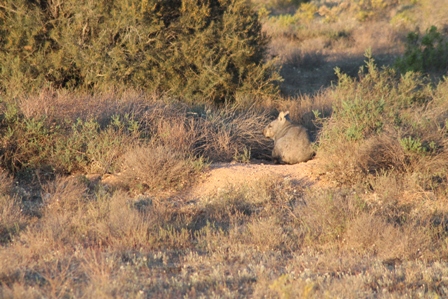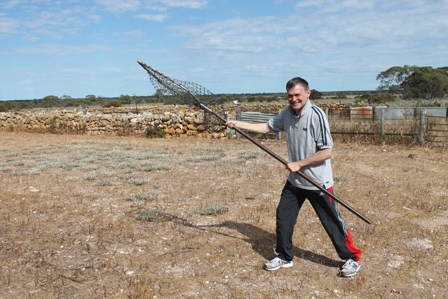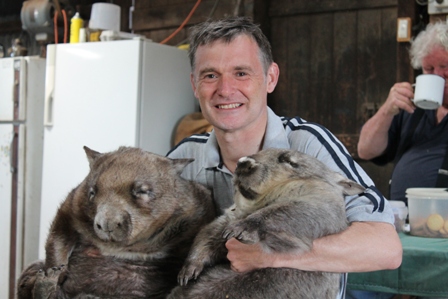
Southern Hairy-nosed Wombat, Swan Reach, South Australia (Dominic Couzens)
7th October 2012
The schedule mysteriously spoke of a “Wombat Muster” for today and tomorrow. But what is a Wombat Muster? Read on and you’ll find out.
The flat country around the Murray River north-east of Adelaide is home to a rare animal known as the Southern Hairy-nosed Wombat (different from the Common Wombat elsewhere in Australia). It lives in arid lands and, like its better known relative, lives in large burrows – Wombats, in fact, are the largest burrow-living mammals in the world. Unlike the other wombat, however, the burrows are concentrated in warrens, like a giant rabbit warren. For some years these animals have been studied by scientists affiliated to Adelaide Zoo. The researchers have a long-term programme of monitoring the population and biometrics of the wombats found at Kooloola Station, near Swan Reach, and to do that they have to catch the animals, weigh them and take all their measurements, dignified or not. Some years ago a bright spark came up with the idea of bringing in outsiders to help with the rounding up (“mustering”) of the animals. That’s where we came in. For one night only, the Wombats of Kooloola would be at the mercy of four middle-aged men from Middle England, armed with nets.
In true Australian fashion, the evening began with a barbie on an open fire under the stars.

- Wombat net the morning after (Dominic Couzens)
The night was surprisingly cold, even so, and most of us were layered up enough to bounce if we fell off the Ute (vehicle) in which we travelled. On the stroke of 10pm we drove off into the shrubland.
Should you ever need to know how to catch SHN Wombats, it’s easy. If you’re a (non-paying) volunteer, you ride standing in the back of a vehicle, net balanced on your feet, while somebody in the middle spotlights the ground ahead. Once a wombat is spotted, two people jump out, one to the left, one to the right, and each runs along the side of the beam towards the target. Ideally, the wombat will simply wait to be netted, but this never actually happens. Instead, a chase begins, which is completely unfair. Wombats and men (our age) run at roughly the same speed, but wombats are on home ground, and as often as not all they have to do is to sprint towards their burrows. However, even if they are spotted on walkabout (waddle-about), for the wombat musterer there is the small problem of wombat burrows, which are about a metre deep. The thrill of the chase, plus the dark, somewhat blinds you as you run towards your fleeing animal, meaning that you are frequently impervious to the chasms lying in wait below you. Over the course of the night, every one of us fell into a wombat burrow in a cloud of dust, disappearing from the view of the spotlight. Most Wombats, therefore had a quiet night.
Wombat Mustering, it turns out, has a high skill level. I know this because Rob Jolliffe, one of our colleagues on the trip, had something – shall we say – of an off night and, despite his best efforts, simply kept missing all available Wombats. The animals only had to jink slightly and he went sprawling in the dust. Several went through his legs and several times he ended up at the mouth of a burrow. I am happy to report that I caught a wombat on my second attempt – evidence of clear aptitude.
Eventually, by 2 am, we had managed to capture five wombats, which were duly placed in hessayon bags and taken back to base; these tough marsupials would sleep peacefully for the rest of the night. After a celebratory bottle of port, we all bedded down in our luxurious accommodation – actually a swag and sleeping bag in a hundred year old sheep-shearing shed. The toilet was 100m away across the mallee.
As morning dawned the wombats were anaesthetised and their various vital measurements taken. As visitors, our contribution was over, save for posing with our new friends.

Mustered Wombats (Dominic Couzens)

Hi Dominic
I just came across your Grown Men vs Wombats article
It is well written and sounds like you had a great time
I am the owner of Kooloola Station and have chased my own fair share of wombats over the years.
The whole Woolshed experience is unique and something most people dont get the opportunity to experience. I bet Ron, Ingrid and David were excellent hosts.
Anyway, I thought I would just say gidday, keep up the good work and hope you can make it back to Kooloola one day.
Best Regards
Terry